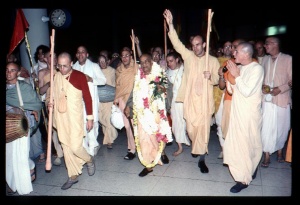CC Adi 7.150 (1975): Difference between revisions
(Vanibot #0027: CCMirror - Mirror CC's 1996 edition to form a basis for 1975) |
(Vanibot #0020: VersionCompareLinker - added a link to the Version Compare feature) |
||
| Line 2: | Line 2: | ||
<div style="float:left">'''[[Sri Caitanya-caritamrta (1975)|Śrī Caitanya-caritāmṛta (1975)]] - [[CC Adi (1975)|Ādi-līlā]] - [[CC Adi 7 (1975)|Chapter 7: Lord Caitanya in Five Features]]'''</div> | <div style="float:left">'''[[Sri Caitanya-caritamrta (1975)|Śrī Caitanya-caritāmṛta (1975)]] - [[CC Adi (1975)|Ādi-līlā]] - [[CC Adi 7 (1975)|Chapter 7: Lord Caitanya in Five Features]]'''</div> | ||
<div style="float:right">[[File:Go-previous.png|link=CC Adi 7.149 (1975)|Ādi-līlā 7.149]] '''[[CC Adi 7.149 (1975)|Ādi-līlā 7.149]] - [[CC Adi 7.151 (1975)|Ādi-līlā 7.151]]''' [[File:Go-next.png|link=CC Adi 7.151 (1975)|Ādi-līlā 7.151]]</div> | <div style="float:right">[[File:Go-previous.png|link=CC Adi 7.149 (1975)|Ādi-līlā 7.149]] '''[[CC Adi 7.149 (1975)|Ādi-līlā 7.149]] - [[CC Adi 7.151 (1975)|Ādi-līlā 7.151]]''' [[File:Go-next.png|link=CC Adi 7.151 (1975)|Ādi-līlā 7.151]]</div> | ||
{{CompareVersions|CC|Adi 7.150|CC 1975|CC 1996}} | |||
{{RandomImage}} | {{RandomImage}} | ||
==== TEXT 150 ==== | ==== TEXT 150 ==== | ||
<div class="verse"> | <div class="verse"> | ||
:ei-mate tāṅ-sabāra | :ei-mate tāṅ-sabāra kṣami' aparādha | ||
:sabākāre kṛṣṇa-nāma karilā prasāda | :sabākāre kṛṣṇa-nāma karilā prasāda | ||
</div> | </div> | ||
| Line 18: | Line 17: | ||
<div class="synonyms"> | <div class="synonyms"> | ||
ei-mate—in this way; tāṅ-sabāra—of all the sannyāsīs; | ei-mate—in this way; tāṅ-sabāra—of all the sannyāsīs; kṣami'-excusing; aparādha—offense; sabākāre—all of them; kṛṣṇa-nāma—the holy name of Kṛṣṇa; karilā—gave; prasāda—as mercy. | ||
</div> | </div> | ||
| Line 32: | Line 31: | ||
<div class="purport"> | <div class="purport"> | ||
Śrī Caitanya Mahāprabhu is the mercy incarnation of the Supreme Personality of Godhead. He is addressed by Śrīla Rūpa Gosvāmī as mahā-vadānyāvatāra, or the most magnanimous incarnation. Śrīla Rūpa Gosvāmī also says, karuṇayāvatīrṇaḥ kalau: it is only by His mercy that He has descended in this Age of Kali. Here this is exemplified. Śrī Caitanya Mahāprabhu did not like to see Māyāvādī sannyāsīs because He thought of them as offenders to the lotus feet of Kṛṣṇa, but here He excuses them (tāṅ-sabāra | Śrī Caitanya Mahāprabhu is the mercy incarnation of the Supreme Personality of Godhead. He is addressed by Śrīla Rūpa Gosvāmī as mahā-vadānyāvatāra, or the most magnanimous incarnation. Śrīla Rūpa Gosvāmī also says, karuṇayāvatīrṇaḥ kalau: it is only by His mercy that He has descended in this Age of Kali. Here this is exemplified. Śrī Caitanya Mahāprabhu did not like to see Māyāvādī sannyāsīs because He thought of them as offenders to the lotus feet of Kṛṣṇa, but here He excuses them (tāṅ-sabāra kṣami' aparādha). This is an example in preaching. Āpani ācari' bhakti śikhāimu sabāre. Śrī Caitanya Mahāprabhu teaches us that those whom preachers meet are almost all offenders who are opposed to Kṛṣṇa consciousness, but it is a preacher's duty to convince them of the Kṛṣṇa consciousness movement and then induce them to chant the Hare Kṛṣṇa mahā-mantra. Our propagation of the saṅkīrtana movement is continuing, despite many opponents, and people are taking up this chanting process even in remote parts of the world like Africa. By inducing the offenders to chant the Hare Kṛṣṇa mantra, Lord Caitanya Mahāprabhu exemplified the success of the Kṛṣṇa consciousness movement. We should follow very respectfully in the footsteps of Lord Caitanya, and there is no doubt that we shall be successful in our attempts. | ||
</div> | </div> | ||
Latest revision as of 19:20, 26 January 2020

A.C. Bhaktivedanta Swami Prabhupada
TEXT 150
- ei-mate tāṅ-sabāra kṣami' aparādha
- sabākāre kṛṣṇa-nāma karilā prasāda
SYNONYMS
ei-mate—in this way; tāṅ-sabāra—of all the sannyāsīs; kṣami'-excusing; aparādha—offense; sabākāre—all of them; kṛṣṇa-nāma—the holy name of Kṛṣṇa; karilā—gave; prasāda—as mercy.
TRANSLATION
Thus Lord Caitanya excused all the offenses of the Māyāvādī sannyāsīs and very mercifully blessed them with kṛṣṇa-nāma.
PURPORT
Śrī Caitanya Mahāprabhu is the mercy incarnation of the Supreme Personality of Godhead. He is addressed by Śrīla Rūpa Gosvāmī as mahā-vadānyāvatāra, or the most magnanimous incarnation. Śrīla Rūpa Gosvāmī also says, karuṇayāvatīrṇaḥ kalau: it is only by His mercy that He has descended in this Age of Kali. Here this is exemplified. Śrī Caitanya Mahāprabhu did not like to see Māyāvādī sannyāsīs because He thought of them as offenders to the lotus feet of Kṛṣṇa, but here He excuses them (tāṅ-sabāra kṣami' aparādha). This is an example in preaching. Āpani ācari' bhakti śikhāimu sabāre. Śrī Caitanya Mahāprabhu teaches us that those whom preachers meet are almost all offenders who are opposed to Kṛṣṇa consciousness, but it is a preacher's duty to convince them of the Kṛṣṇa consciousness movement and then induce them to chant the Hare Kṛṣṇa mahā-mantra. Our propagation of the saṅkīrtana movement is continuing, despite many opponents, and people are taking up this chanting process even in remote parts of the world like Africa. By inducing the offenders to chant the Hare Kṛṣṇa mantra, Lord Caitanya Mahāprabhu exemplified the success of the Kṛṣṇa consciousness movement. We should follow very respectfully in the footsteps of Lord Caitanya, and there is no doubt that we shall be successful in our attempts.